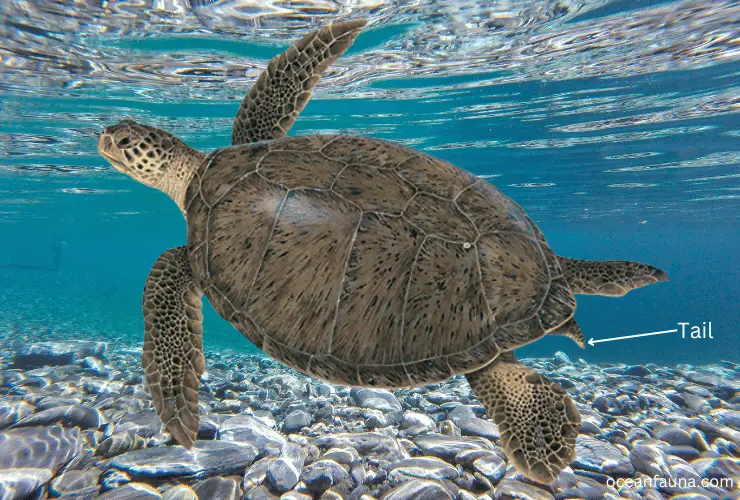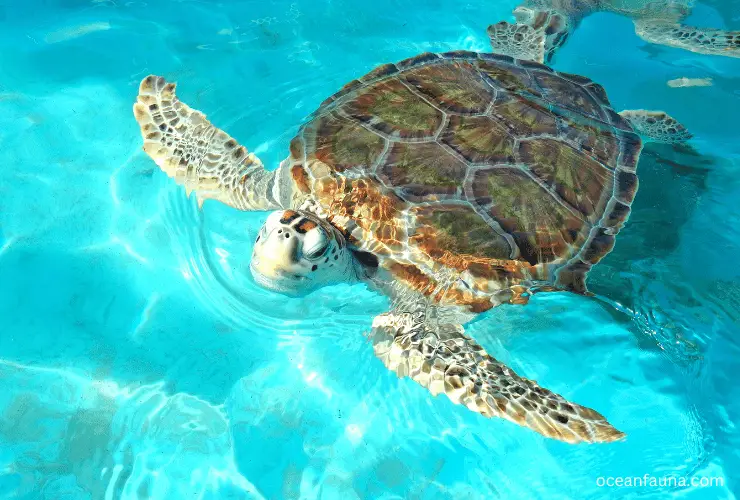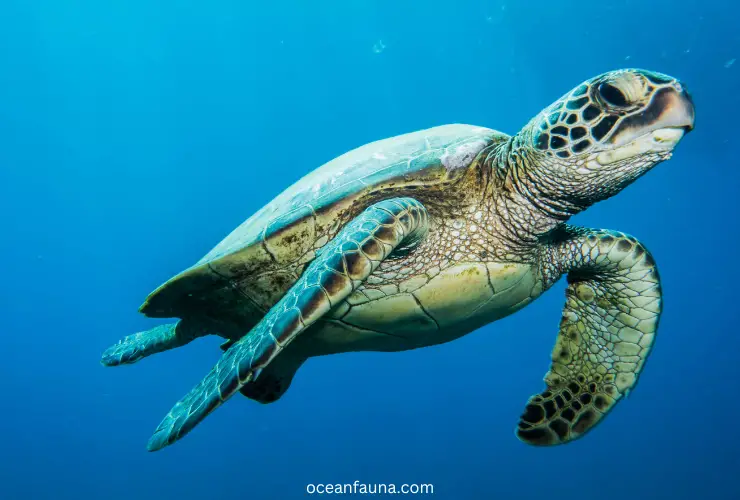It is no surprise at all that sea turtles do have tails. Just by looking at a sea turtle’s tail, one can identify whether it is a male or a female sea turtle. Male sea turtles’ tails are much longer than the tails of female sea turtles.
Sea turtles are some of the most fascinating marine creatures. People all around the world have been interested in these kinds of turtles. Just like other animals, sea turtles also have some characteristics that help them adapt to life in the ocean.
One of the most distinctive features among their unique characteristics is their tail. Despite some variations among species, their tail is an integral part of their anatomy.
Now that we know this, let’s dive deeper into the world of sea turtles and learn the mysteries of their tails and why they’re so important for their everyday lives.
Do Sea Turtles Have Tails?

Just like we learned earlier, yes, sea turtles do possess tails. However, the sizes and appearances of their tails can vary between different species. A sea turtle’s tail is an essential component of its anatomy and plays a crucial role in its marine life.
All kinds of sea turtles: freshwater turtles, sea turtles, and tortoises, have tails. Their tails play a huge role in reproduction. Moreover, their tails also serve to safeguard the cloaca, a vital opening for waste elimination and reproduction. For some species, the tail also plays an extremely important role in maintaining equilibrium.
Are Sea Turtle Tails Prehensile?
Prehensile is a word that refers to the capability of an animal’s body part to hold or manipulate objects. A prehensile body part is there to assist in grasping something and can curl around objects with a certain level of control.
Animals that are prehensile are those that need to interact and manipulate their environment to climb, feed, or handle objects. Sea turtles are naturally wary of certain situations. However, this is only present in males and is only used during mating.
What do sea turtles’ tails look like?
As we discussed earlier, the tails of sea turtles come in many variations and different shapes and sizes, depending on their species. In contrast to other sea and land animals, sea turtles’ tails are short and less prominent.
A sea turtle’s tail is usually smooth and covered with scales, just like the rest of the turtle’s body. In some species, male sea turtles have slightly longer and thicker tails than females, which only happens after maturity. Their tails are also used to assist in reproductive functions in males.
Sea Turtle Tail Anatomy (Length, Shape, etc.)

Sea turtles have many different features as compared to other kinds of turtles and tortoises. Here are some details of the anatomy of a sea turtle’s body, including its length, shape, etc.
- Shape and size: Adult green turtles measure from 3 to 4 feet in carapace length, which is also around 83 to 114 cm. As for weight, fully-grown adult sea turtles generally weigh between 240 and 420 pounds.
- External skeleton: In almost all sea turtle species, the external skeleton is split into two halves known as the upper carapace and the lower plastron. This shell, or skeleton, is what guards the internal organs of the turtle. The carapace is covered with firm yet flexible structures known as scutes. These scutes have different kinds of bones, including the nuchal, vertebral, costal, and marginal varieties, and are positioned differently on the carapace.
- Internal skeleton: The internal skeleton has a little bit of a different function from the external skeleton. This skeleton helps provide a foundation for the turtle’s muscles. However, in the leatherback turtle’s case, the spine is connected to the carapace.
- Eyes and mouths: Sea turtles are one of the animals that lack teeth. Instead of having teeth, their mouths have a beak-like structure that allows them to crush and tear food apart. The turtle’s eyes are made in such a way that they help the turtles see underwater. They have a gland near the eyes that releases excess salt and fluids and helps keep their eyes moist on land.
- Flippers: Sea turtles also have flippers that are large and sensitive to touch. However, these flippers play a very crucial role in sea turtle life. The front flippers produce a figure-eight movement to help the sea turtle propel itself through the water. On the other hand, their rear flippers maintain their direction and stability while they swim.
- Adaptations of the leatherback turtle: Unlike other species, the leatherback sea turtle has some very unique and different adaptations. These include its lack of a bony shell and its spine not being fused with the carapace. Instead of having these features that are present in normal species of sea turtles, it relies on leathery skin supported by tiny bones. This unique feature is the reason why these turtles can dive up to three thousand feet underwater, where the water pressure is very high!
Purpose and Functions of Sea Turtle’s Tail
The sea turtle’s tail holds remarkable significance in the marine life of sea turtles. Let’s explore what the functions of their tails are.
The first and most important function of a sea turtle’s tail is that it aids in propelling and guiding these creatures under the water while also helping maintain balance during swimming. This is the most important component of their tails, aiding in effective navigation and ensuring their survival.
Moreover, their tails also help the turtles withstand the water’s high pressure. Their tails have distinct qualities that allow sea turtles to survive and thrive in deep waters.
Additionally, essential to their ability to move forward gracefully and with sufficient power is the function of their tails. They can be seen moving their tails during a variety of behaviors, including feeding, mating, and migration.
In a nutshell, the sea turtle’s tail is an essential component of them, aiding in their ability to survive. From helping in balancing and swimming to adapting to its marine environment, without their tails, they wouldn’t have been able to survive.
Do Sea Turtles Use Their Tails While Mating?

The answer to this question without any confusion is yes. Sea turtles do use their tails while mating. In fact, without their tails, it wouldn’t have been possible for sea turtles to mate.
Both male and female sea turtles have a part called the cloaca that is used as both a waste and reproductive opening. The cloaca is located at the base of their tails. In the case of males, this cloaca also accommodates their penis.
When mating, the male moves his tail underneath the rear end of the female’s shell, and then from his cloaca, he reaches almost half the length of his shell to inseminate the female’s cloaca and penetrate it.
FAQs
What turtle has the most extended tail?
Snapping turtles and big-headed turtles have the most extended tails. The big-headed turtle uses its long tail to help it stay balanced while climbing. However, in general, turtles have shorter tails compared to other reptiles. These tails can be different in size and shape among species and between males and females.
Do Male Sea Turtles Have Longer Tails Than Female Sea Turtles?
Yes, male sea turtles have longer and thicker tails as compared to females. This is because the male reproductive organ is located at the base of the tail. However, male and female sea turtles look similar until they grow older and only look different when they reach maturity.
Do Sea Turtles Use Their Tails for Defense?
Yes, a sea turtle’s tail can be used as self-defense for the back of its body. Turtles typically keep their tails down when not excreting waste or mating. Land-based turtles can retract their tails into their shells when necessary, whereas sea turtles lack this ability but can use their tails to protect themselves from danger.
Do Sea Turtle Tails Grow Back?
No, sea turtles and any other turtles’ tails do not grow back. While lizards can regenerate lost tails, the same does not apply to turtles. Hence, once a turtle’s tail is injured, it cannot grow back.
How Do Sea Turtles Use Their Tails to Swim?
Unlike fish and other aquatic creatures, sea turtles do not use their tails to help them swim. They don’t rely on their tails for balance or climbing either, as land-based animals do.
Conclusion
In short, sea turtles do have tails, with variations in size and appearance depending on the species. These tails are an important feature in their anatomy and serve some very important functions. Males typically have longer and thicker tails, which are crucial for reproduction.
Their tails are essential for their marine survival. They not only aid in swimming and maintaining balance but also assist in propelling forward. Even during mating, the male’s tail plays a significant role in the reproductive process.


1 thought on “Do Sea Turtles have Tails? [Tail Anatomy & Function]”